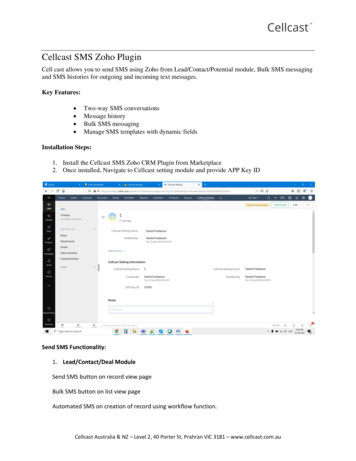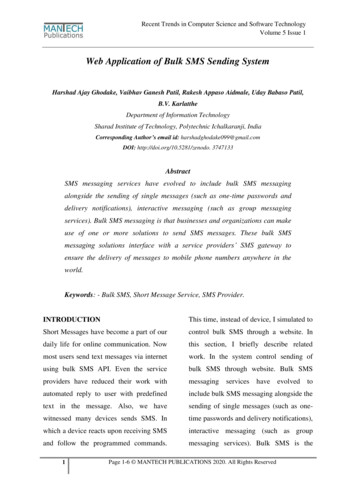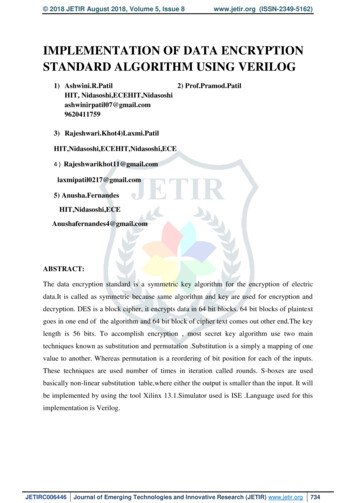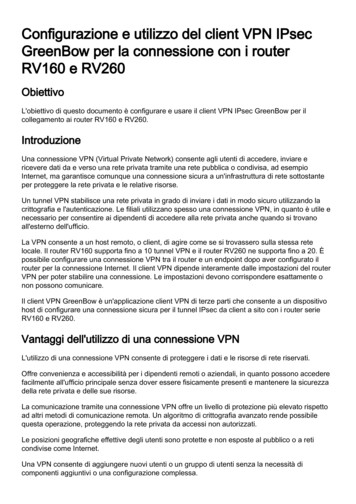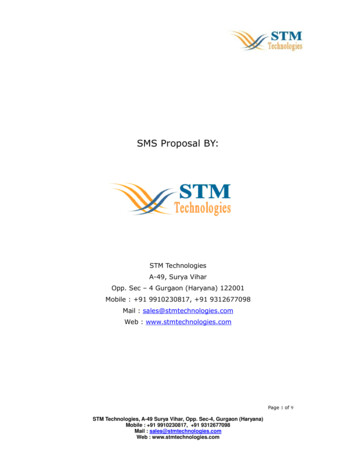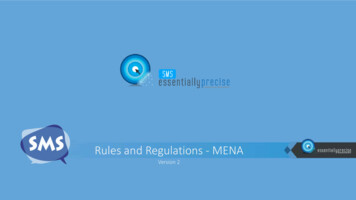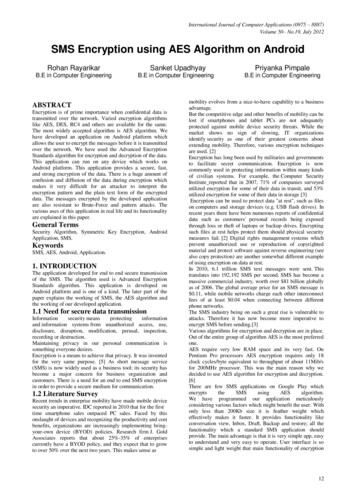
Transcription
International Journal of Computer Applications (0975 – 8887)Volume 50– No.19, July 2012SMS Encryption using AES Algorithm on AndroidRohan RayarikarB.E in Computer EngineeringSanket UpadhyayB.E in Computer EngineeringABSTRACTEncryption is of prime importance when confidential data istransmitted over the network. Varied encryption algorithmslike AES, DES, RC4 and others are available for the same.The most widely accepted algorithm is AES algorithm. Wehave developed an application on Android platform whichallows the user to encrypt the messages before it is transmittedover the network. We have used the Advanced EncryptionStandards algorithm for encryption and decryption of the data.This application can run on any device which works onAndroid platform. This application provides a secure, fast,and strong encryption of the data. There is a huge amount ofconfusion and diffusion of the data during encryption whichmakes it very difficult for an attacker to interpret theencryption pattern and the plain text form of the encrypteddata. The messages encrypted by the developed applicationare also resistant to Brute-Force and pattern attacks. Thevarious uses of this application in real life and its functionalityare explained in this paper.General TermsSecurity Algorithm, Symmetric Key Encryption, AndroidApplication, SMS.KeywordsSMS, AES, Android, Application.1. INTRODUCTIONThe application developed for end to end secure transmissionof the SMS. The algorithm used is Advanced EncryptionStandards algorithm. This application is developed onAndroid platform and is one of a kind. The later part of thepaper explains the working of SMS, the AES algorithm andthe working of our developed application.1.1 Need for secure data transmissionInformationsecurity meansprotectinginformationand information systems from unauthorized access, use,disclosure, disruption, modification, perusal, inspection,recording or destruction.Maintaining privacy in our personal communication issomething everyone desires.Encryption is a means to achieve that privacy. It was inventedfor the very same purpose. [5] As short message service(SMS) is now widely used as a business tool; its security hasbecome a major concern for business organization andcustomers. There is a need for an end to end SMS encryptionin order to provide a secure medium for communication.1.2 Literature SurveyRecent trends in enterprise mobility have made mobile devicesecurity an imperative. IDC reported in 2010 that for the firsttime smartphone sales outpaced PC sales. Faced by thisonslaught of devices and recognizing the productivity and costbenefits, organizations are increasingly implementing bringyour-own device (BYOD) policies. Research firm J. GoldAssociates reports that about 25%-35% of enterprisescurrently have a BYOD policy, and they expect that to growto over 50% over the next two years. This makes sense asPriyanka PimpaleB.E in Computer Engineeringmobility evolves from a nice-to-have capability to a businessadvantage.But the competitive edge and other benefits of mobility can belost if smartphones and tablet PCs are not adequatelyprotected against mobile device security threats. While themarket shows no sign of slowing, IT organizationsidentify security as one of their greatest concerns aboutextending mobility. Therefore, various encryption techniquesare used. [2]Encryption has long been used by militaries and governmentsto facilitate secret communication. Encryption is nowcommonly used in protecting information within many kindsof civilian systems. For example, the Computer SecurityInstitute reported that in 2007, 71% of companies surveyedutilized encryption for some of their data in transit, and 53%utilized encryption for some of their data in storage [3]Encryption can be used to protect data "at rest", such as fileson computers and storage devices (e.g. USB flash drives). Inrecent years there have been numerous reports of confidentialdata such as customers' personal records being exposedthrough loss or theft of laptops or backup drives. Encryptingsuch files at rest helps protect them should physical securitymeasures fail. [2] Digital rights management systems whichprevent unauthorized use or reproduction of copyrightedmaterial and protect software against reverse engineering (seealso copy protection) are another somewhat different exampleof using encryption on data at rest.In 2010, 6.1 trillion SMS text messages were sent. Thistranslates into 192,192 SMS per second. SMS has become amassive commercial industry, worth over 81 billion globallyas of 2006. The global average price for an SMS message is 0.11, while mobile networks charge each other interconnectfees of at least 0.04 when connecting between differentphone networks.The SMS industry being on such a great rise is vulnerable toattacks. Therefore it has now become more imperative toencrypt SMS before sending.[3]Various algorithms for encryption and decryption are in place.Out of the entire group of algorithm AES is the most preferredone.AES require very low RAM space and its very fast. OnPentium Pro processors AES encryption requires only 18clock cycles/byte equivalent to throughput of about 11Mib/sfor 200MHz processor. This was the main reason why wedecided to use AES algorithm for encryption and decryption.[6]There are few SMS applications on Google Play whichencryptstheSMSusingAESalgorithm.We have programmed our application meticulouslyconsidering various factors which might benefit the user. Withonly less than 200Kb size it is feather weight whicheffectively makes it faster. It provides functionality likeconversation view, Inbox, Draft, Backup and restore; all thefunctionality which a standard SMS application shouldprovide. The main advantage is that it is very simple app, easyto understand and very easy to operate. User interface is sosimple and light weight that main functionality of encryption12
International Journal of Computer Applications (0975 – 8887)Volume 50– No.19, July 2012and decryption of SMS is carried out very efficiently.2. SHORT MESSAGE SERVICE (SMS)SMS stands for short message service. Simply put, it is amethod of communication that sends text between cellphones, or from a PC or handheld to a cell phone. The "short"part refers to the maximum size of the text messages: 160characters (letters, numbers or symbols in the Latin alphabet).For other alphabets, such as Chinese, the maximum SMS sizeis 70 characters.notunlimited.During the SMS delivering, sender cell phone and SMSC isactivelycommunicating.So, if the non-active destination cell phones become active,SMSC directly notifies the sender cell phone and tell that theSMS delivering is success.This is how the SMS works in general. The following partdescribes the AES algorithm.3. ADVANCE ENCRYPTIONSTANDARDS ALGORITHM/ RIJNDAELALGORITHMThe Advanced Encryption Standard comprises three blockciphers, AES-128, AES-192 and AES-256. AES has a fixedblock size of 128 bits and a key size of 128, 192, or 256 bits.The block-size has a maximum of 256 bits, but the key-sizehas no theoretical maximum. The cipher uses number ofencryption rounds which converts plain text to cipher text.The output of each round is the input to the next round. Theoutput of the final round is the encrypted plain text known ascipher text. The input given by the user is entered in a matrixknown as State Matrix. [2]Fig. 1: Transmission of SMS2.1 Working of SMSIt is well-known that SMS service is a cell phone feature butindeed, SMS can also work on other computing devices suchas PC, Laptop, or Tablet PC as long as they can accept SIMCard. SIM Card is needed because SMS service needs SMScenter client which is built-in on the SIM Card.2.1.1 BTSA base transceiver station (BTS) is a piece of equipment thatfacilitates wireless communicationbetween userequipment (UE) and a network. UEs are devices like mobilephones (handsets), WLL phones, computers with wirelessinternet connectivity, WiFi and WiMAX devices and others.2.1.2 MSCThe mobile switching center (MSC) is the primary servicedelivery node for GSM/CDMA, responsible for routing voicecalls and SMS as well as other services (such as conferencecalls, FAX and circuit switched data).[2]The MSC sets up and releases the end-to-end connection,handles mobility and hand-over requirements during the calland takes care of charging and real time pre-paid accountmonitoring.2.1.3 SMSCWhen SMS is transmitted from a cell phone, the message willbe received by mobile carrier‟s SMS Center (SMSC), dodestination finding, and then send it to destination devices(cellphone).SMSC is SMS service center which is installed on mobilecarrier core networks. Beside as SMS forwarding, SMSC alsoacts as temporary storage for SMS messages. So, if thedestination cell phone is not active, SMS will store themessage and then deliver it after the destination cell phone isactive. As additional, SMSC also notify the sender whetherthe SMS delivering is success or not. However SMSC cannotstore the SMS message forever since the storage capacity isFig. 2: State MatrixFollowing are the four steps.3.1 SubBytes StepThis step is same as SubBytes step of AES algorithm. In theS-Box Substitution step, each byte in the matrix is reorganizedusing an 8-bit substitution box. This substitution box is calledthe Rijndael S-box. This operation provides the non-linearityin the cipher. The S-box used is derived from themultiplicative inverse over GF (28), known to have good nonlinearity properties. To avoid attacks based on simplealgebraic properties, the S-box is constructed by combiningthe inverse function with an invertible affine transformation.The S-box is also chosen to avoid any fixed points (and so is aderangement), and also any opposite fixed points. [7] Thisstep causes confusion of data in the matrix. S-BoxSubstitution is carried out separately for LPT and RPT. This isthe first step of iterative round transformation. The output ofthis round is given to the next round. [3]3.2 ShiftRows StepThe ShiftRows step is performed on the rows of the statematrix. It cyclically shifts the bytes in each row by a certainoffset. The first row remains unchanged. Each byte of thesecond row is shifted one position to the left. Similarly, thethird and fourth rows are shifted by two positions and threepositions respectively. The shifting pattern for block of pIn the MixColumns step, the four bytes of each column of thestate matrix are combined using an invertible lineartransformation [5]. A randomly generated polynomial isarranged in a 4*4 matrix. The same polynomial is used duringdecryption. Each column of the state matrix is XOR-ed with13
International Journal of Computer Applications (0975 – 8887)Volume 50– No.19, July 2012the corresponding column of the polynomial matrix. Theresult is updated in the same column. The output matrix is theinput to AddRoundKey.[3]3.4 AddRoundKeyA round key is generated by performing various operations onthe cipher key.This round key is XOR-ed with each byte of the state matrix.For every round a new round key is generated usingRijndael‟s key scheduling algorithm. [3]3.6.3 MixColumns:public byte[ ][ ] mixColumns(byte[ ][ ] state){for (int c 0;c 4;c ){state [c] matrixMultiplication(state[c], polynomial);}return state;}3.5 Decryption of the Proposed AlgorithmThe encryption algorithm is referred to as the cipher and thedecryption algorithm as the inverse cipher. In addition, thecipher and the inverse cipher operations must be executed insuch a way that they cancel each other. The rounds keys mustalso be used in reverse order. [4] The Cipher Text which isformed of 256-bit 4*8 Matrix is the input for the decryptionprocess. [3]3.6 ImplementationThe algorithm can be implemented in any language. Thisalgorithm can also be used in Image Processing. We haveimplemented it in java, java being an open source andplatform independent language. The pseudo codes for thecomponents of the cipher are given below. [3]3.6.1 Add Round key:public byte[ ][ ] addRoundKey(byte[ ][ ] state,byte[ ][ ]roundkey){for (int i 0;i 4;i ){for (int j 0;j 4;j ){state [i][j] doExclusiveOR(state[i][j],roundkey[i][j]);}}return state;}3.6.2 Substitute Bytes:public byte[ ][ ] subBytes(byte[][] state){for (int i 0;i 4;i ){for (int j 0;j 4;j ){int row getFirstFourBits(state[i][j]);int column getSecondFourBit(state[i][j]);state[i][j] sBoxSubstitution(row,column);}}return state;}3.6.4 ShiftRows:shiftRows(byte state[][]){for(int i 0;i 4;i ){//cyclic left shifts „i‟th row, „i‟timescyclicLeftShift(i);}}3.7 Strength of the AlgorithmThe cipher key used in the algorithm is of 128 bits. Therefore,to break the cipher key an attacker has to check 2 128possibilities which are practically almost impossible.Therefore, the Brute-force Attack fails on this algorithm.The flow of the algorithm makes sure that there is no fixedpattern in any of the steps of the algorithm. The componentsof the proposed algorithm have brought about strong diffusionand confusion. Therefore, statistical and pattern analysis ofthe ciphertext fails. [4]The most important security advantage is that no differentialor linear attacks can break this algorithm. [9]4. SMS APPLICATIONThe application works in following way:1. The user opens the application and authenticatesusing pattern lock.2. User can either type new message or reply to anexisting message.3. If new message is selected, user enters the messageand presses encrypt button after inserting therecipient‟s name. The user has to enter a cipher keybefore the message is sent. The cipher key is autogenerated if the user does not enter one.4. If the user selects to reply to an existing message, hefirst decrypts the message by long pressing themessage and then types in the reply. The user isasked to enter cipher key before the message is sent.5. Once the cipher key is entered, the message issuccessfully sent and is shown in encrypted form inthe thread.4.1 Application SnapshotsSome of the snapshots of the application are shown below. Itshould be noted that due to obvious reasons we are notsharing the entire layout of the application. However, few ofthe important snapshots are given below.14
International Journal of Computer Applications (0975 – 8887)Volume 50– No.19, July 20124.1.1 Pattern LockUser may save the message as draft or send it by entering thecipher key. User can choose any recent contact from his calllog by pressing „Recent‟ button.4.1.3 Thread ViewThe messages in the application inbox are shown in form ofthread. Long pressing on the thread gives option to delete thethread or open the contact information of the thread or call thecontact to whom the thread belongsFig. 3: Pattern LockThis is used by the user to authenticate his identity. The usermay change the lock code once he authenticates and logs intothe application. After 5 incorrect attempts the applicationcloses.4.1.2 Create MessageThe user types in the message along with the name of thesender. The relevant contact information is displayed in thedropdown menu as the user starts to write the name. He canthen select the name and the number which is displayed indropdown menu. If suppose user types „ro‟ in the name fieldthen all the contacts having initials „ro‟ or containing „ro‟ as asub-text are displayed in the dropdown menu below it alongwith the telephone number.Fig. 4: Create MessageFig. 5: Message Inbox4.1.4 Thread ViewThe messages are displayed in thread format. For ease ofunderstanding we have shown the first two messages in theencrypted form and the last two are in decrypted form. Theencrypted message is decrypted by using AES decryption.Fig. 6: Messages in Encrypted and Decrypted Form15
International Journal of Computer Applications (0975 – 8887)Volume 50– No.19, July 20124.2Features of this Application4.5.1 Send MessageFollowing are some of the features of the application:1. All messages in thread are displayed in encryptedformat to both sender and receiver.2. Long pressing the thread will pop-up an action boxwherein the user can delete, view contact details orcall the recipient.3. Long pressing any message in the thread will popup an action box wherein the user can delete,forward or decrypt the message.4. The cipher key is randomly generated if the userdoes not enter it.5. Various settings such as notification settings,Display settings, Encryption settings, Tone settings,Personalization settings are available for the user‟sconvenience.6. This application is developed on Android platform.The reason behind using Android platform is similarto other operating systems for mobile devices;Android OS supports connectivity, messaging,language support, media support, Bluetooth etc. Themain feature of android would be open sourcetechnology and JAVA support. It also supportsmultitasking, multi touch, Wi-Fi, tethering, 3Gservices, and very importantly security and privacy.In Android, There is a class SmsManager. We create instanceof this class and there is a sendTextMessage() method inSmsManager class.4.3 Goals of this applicationThe main goals of our application are:1. Developing a secure SMS application.2. Maintaining encrypted information of messagerecipients.3. Decrypting of message as per users requirement.4. Protection against misuse of message information.5. High confidentiality and improved security4.3.1 Commercial DomainIn some commercial setups it is very must that informationflow between various departments remain private and otherdepartment people should not come to know. This applicationcan be used in such cases where the numbers and digits havemore importance than documentations. The proposedapplication can be used for secured transactions on network.[5]4.3.2 Non-Commercial and Personal UseThere are sometimes when the user would like to keep talksbetween two people private and confidential. During suchtimes, SMS encryption is a boon. An intruder would not beable to understand the message unless he has a properauthentication key.void sendSMS(String text,String number){SmsManager sms ,null,text,null,null);// last two parameters in sendTextMessage method arePendingIntent// sentIntent & deliveryIntent.}4.5.2 Receive MessageFor receiving any messages we create one BroadcastReciver.And we override onRecieve method of it which is basicallycalled by system when any messages are received. But to doso we first have to register our reciver.public void onRecive(Context c, Intent i){Bundle b i.getExtras();if(b! null){// Retrive received messagebyte[] pdus bundle.get(“pdus”);// converting bytes into MessageSmsMessages[] msgs new SmsMessages[pdus.length];for(int j 0;j msgs.length;j ){msgs[j] SmsMessage.createFromPdu(pdus[j]);// Here we can display the Sms by getDisplayMessageBody()method of SmsMessage class}}}4.5.3 NotificationUsing NotificationManager and Notification classes we caneasily create and display notifications on receiving message.public void createNotification(Context ctx){NotificationManager notifManager (NotificationManager)getSystemService(NOTIFICATION SERVICE);// create object of Notification classNotification notification new Notification();4.4 ScopeThe application is built on Android platform. Therefore, it canbe used on any device which runs on Android operatingsystem. This application can be used in industries for secureddata transfer. Apart from commercial and business use, thisapplication can be used for non-commercial and personal use.[6] The purpose of this application is secured data transferbetween two devices.4.5 Pseudo Codes of Android ApplicationWe have written the code in Android language. The originalcodes are not given for obvious reasons. However, the mainlogic of the codes are given.// set the notification details. Here last parameter , “title”, “notification text”,null);// Notify the systemnotifManager.notify(0,notification);}16
International Journal of Computer Applications (0975 – 8887)Volume 50– No.19, July 20125. CONCLUSIONAs a conclusion the requirements for speed and compactnesswere met. The program size is 50 kB and it can be installedinto a mobile phone working on Android platform. The userexperiences no delays while using the program, which is aclear indication that the speed requirement is met. We madesure that the user interface simple and straight forward to use.In applications, where access control is vital, our applicationcan be used to authenticate the sender of a message.Also it is possible to detect, if the message has been corruptedor tampered with during transmission. Most importantly, themessages containing delicate information are stored securelyand remain undisclosed even when the device is accessed byan adversary. The most unique and vital point to beconsidered is the security of the encrypted data againstvarious attacks such as Brute Force attack, pattern attack etc.This application guarantees secure end to end transfer of datawithout any corrupt data segments.6.REFERENCES[1] J.Daemen and V.Rijmen, AES Proposal: es.“AnnouncingtheAdvancedEncryption Standard (AES)”,Federal InformationProcessing Standards Publication 197, November 2001[3] Hassinen M.: SafeSMS 1.0 user manual. October2004,Department of Computer Science, University ofKuopio.[4] http://www.cs.uku.fi/ mhassine/SafeSMS/Manualen.pdf[5] G. Racherla, D. Saha, “Security and Privacy Issues inWireless and Mobile Computing”, Proceedings of 2000IEEE International Conference on Personal WirelessCommunications, Dec 17-20, 2000, pp.509-513.[6] [6]H. Marko, H. Konstantin, “Strong MobileAuthentication”,Proceedings of 2nd InternationalSymposium on WirelessCommunication Systems, Sept5-7 2005, pp.96-100.[7] Xinmiao Zhang and Keshab K. Parhi, “ImplementationApproaches for the Advanced Encryption StandardAlgorithm”, 1531-636X/12, IEEE 2002.[8] Chun Yan,Yanxia Guo, “A Research and ImprovementBased on Rijndael Algorithm”, 2009 First neering,Nanjing, Jiangsu China, December 26December 28, ISBN:978-0-7695-3887-7[9] /wiki/Advanced Encryption Standard[2] Priyanka Pimpale, Rohan Rayarikar and SanketUpadhyay, “Modifications to AES Algorithm forComplex Encryption”, IJCSNS International Journal ofComputer Science and Network Security, VOL.11No.10, October 2011.17
Fig. 1: Transmission of SMS 2.1 Working of SMS It is well-known that SMS service is a cell phone feature but indeed, SMS can also work on other computing devices such as PC, Laptop, or Tablet PC as long as they can accept SIM Card. SIM Card is needed because SMS service needs SMS center client which is built-in on the SIM Card. 2.1.1 BTS
